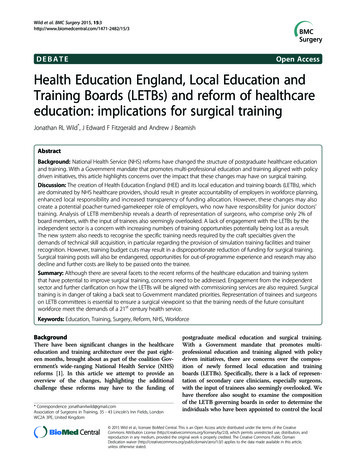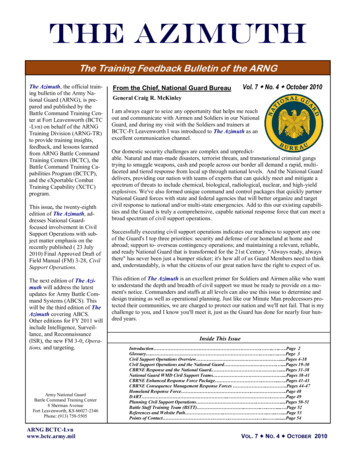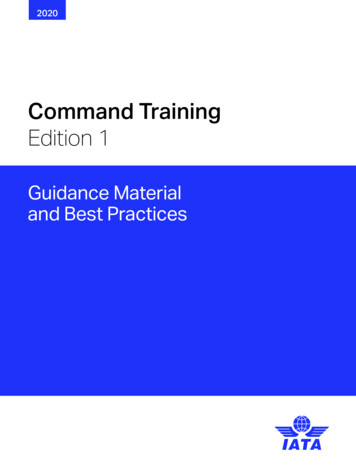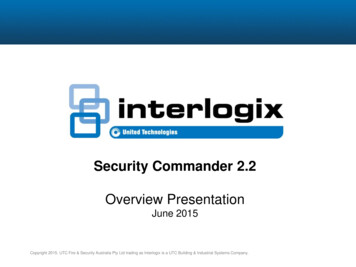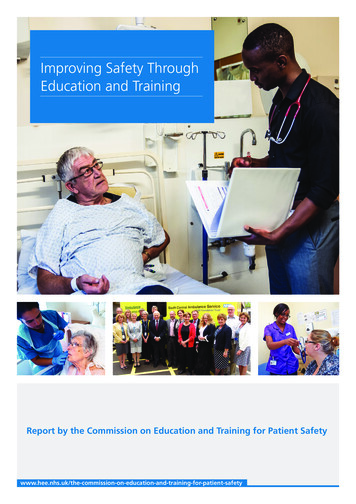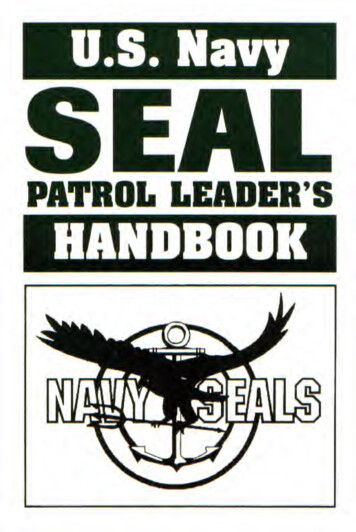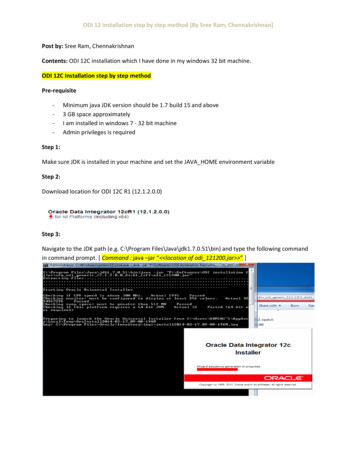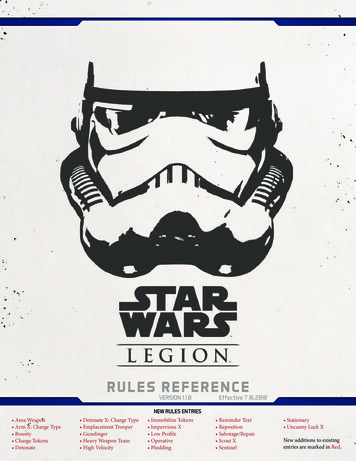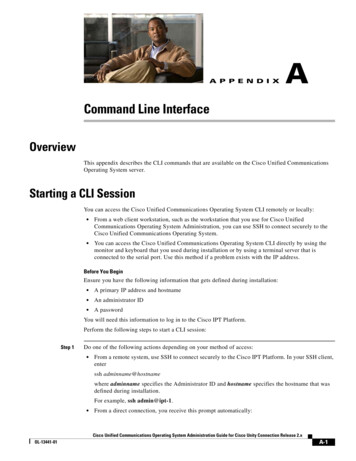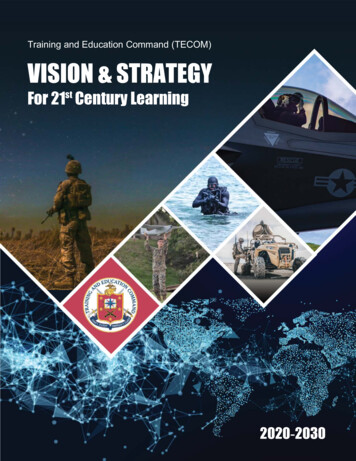
Transcription
Training and Education Command (TECOM)VISION & STRATEGYFor 21st Century Learning2020-2030
FOR MORE INFORMATION, PLEASE CONTACT:AC/S, G-5 Division (703) 784-0115i
A Message from Major General William F. Mullen IIIAs addressed in the 38th Commandant’s Planning Guidance, the warfighting advantageswe once enjoyed are fading. The increasing lethality of our potential adversaries on land,on and under the sea, in the air, in space, and in cyberspace have diminished the efficacyof our historical advantages in both manpower and warfighting technology. New conceptssuch as distributed operations and expeditionary advanced based operations in degradedCommand and Control environments are becoming the norm. But while the nature ofconflict changes, one constant remains: the need for Marines with an intellectual edge;that is, Marines who can envision and execute maneuver warfare that is adaptively basedon mission-type orders, Marines who do not wait for detailed directions before takingdecisive action in battle, and Marines who can outthink and outperform any opponentacross multiple dimensions of warfare. Tactics, warfighting technologies, our battlespace and our potentialadversaries continue to evolve, creating ever increasing volatility and complexity across the spectrum of conflict.As the world evolves, so must the way that we create and cultivate Marines. The hallmark of who we are is a forceof fit, disciplined, adaptive warriors that are capable of overcoming any adversary in any clime or place. Advancesin technologies and warfighting systems demand that Marines understand how to effortlessly operate in a multidomain operational environment. The “Strategic Corporal” described by our former Commandant General Krulaknow has a multitude of systems to enhance their knowledge of their operating environment and platforms that allowthem to engage the enemy in ways never before imagined. The creation of these “Enlightened Warriors” demandsan upgrade of our Training and Education system. Currently, many of our schools and training venues are firmlybased in the “lecture, memorize facts, regurgitate facts on command” model of industrial age training and education.The evolution on the battlefield demands that Marines think and act using the full arsenal of tools that empowerthem to know, and then act, in an adaptive fashion. Operating in the Information Age demands that we elevate ourinstructional methodologies to create a learning environment commensurate with the environment in which ourMarines will fight. This information age developmental approach will focus on active, student-centered learningusing a problem-posing methodology where our students/trainees are responsible for their own learning andsupported by skilled instructors who facilitate learning experiences. These instructors must ensure Marines arechallenged with problems to solve and are able to work in groups so as to learn by doing and also from each other.We must be able to do this in an increasingly dynamic environment that encompasses concepts like the proliferationof capabilities in information sharing and denial and the increasing lethality of our potential adversaries in alldomains. Training and Education Command (TECOM) will lead the way in transforming the Corps to an informationage learning model.As the organization that trains and educates the force, it is incumbent upon TECOM to transform formal learning inthe Marine Corps in order to accelerate the development of critical thinking, judgment, and bias for intelligent actionin our Marines and warfighting units. The envisioned future Marine Corps Training Environment (MCTE) will takeadvantage of systems’ integrated and joint interoperable live-, virtual and constructive capacity to enable the MarineCorps to hone its decisive edge as a naval expeditionary force-in-readiness, wherever our country needs us to be thefirst to fight.Major General William F. Mullen IIICommanding General, TECOMii
INTRODUCTIONINTRODUCTIONTraining and Education Command’s (TECOM’s)purpose is to support the Marine Corps'preparation for war in order to ensure theFleet Marine Forces (FMFs) win our nation'sbattles and are effective in other actions, insupport of national interests.TECOMsupports the FMF by transforming civiliansinto Marines, training and educating individualMarines at formal schools, and enabling theexercise and evaluation of our navalexpeditionary forces at all echelons. As theMarine Corps’ training and educationproponent, TECOM will develop and employinnovative methodologies and technologiesthat support the FMF’s preparation for war.This strategy will ensure that training andeducation are aligned with the Commandantof the Marine Corps’ Planning Guidance (CPG).Currently, many of our schools and trainingvenues are firmly entrenched in the industrialage model of training and education. We musttransform our legacy approach of training andeducation to advance the intellectual edge ofour Marines and the combat effectiveness ofour units. Going forward, we must leveragemore fully the growing bodies of knowledge inadult learning, human performance science,and talent management in the development ofour Marines, instructors, faculty, and units. Inconjunction with the transformation fromindustrial age to information age, this strategyrequires that TECOM continue to achieve its1day-to-day mission of making Marines,training and educating Marines, and enablingcommanders to exercise and evaluate theirunits in order to prepare for combat. In someareas, Recruit Training for example, we maynot substantially change our trainingmethodology.The transformation from an industrial agemodel to an information age model of learningwill demand new approaches, methodologiesand significant resources. Many of theseresources will be beyond TECOM’s ability tosource internally. However, TECOM willdetermine ways to divest legacy systems andcapabilities, and will re-direct those resourcesappropriately to requirements identified in theCPG. TECOM will seek internal solutionswhere practicable in order to reduce theinstitutional risk to the Marine Corps as itinvests in new systems and capabilitiesrequired for this transformation.This strategy serves as the authoritativedocument for Service-level training andeducation, and provides a common directionto TECOM as we move from an industrial agemodel of training and education to aninformation age model of learning. Thisstrategy provides the training and educationpriorities for accomplishing our mission andestablishes a shared vision for improving theeffectiveness of Marine Corps learning.
STRATEGIC VISIONSTRATEGIC VISIONAs TECOM transitions its training and education systeminto an information age learning model, we will strengthenthe tenets of maneuver warfare and emphasize a greaternaval orientation. First, TECOM will provide training andeducation that supports the development of one force that isoptimized for naval expeditionary warfare in support of naval fleets.To support greater naval orientation, we will undergo a sustainable andaggressive naval education program. This program will develop a greaterunderstanding of naval theory, composite warfare, and naval tactics. TECOMwill continue to encourage Navy partners’ the participation at our formal schools.Second, we will maximize our warfighting capabilities while minimizing the time thatit takes to do so. To support this effort, we will take a competency-based approach tolearning that enables Marines to learn more effectively by focusing on learning outcomesover processes. Consequently, we will employ emerging simulation technologies such asintegrated Live, Virtual, and Constructive (LVC) environments, to enable Marines apply theirwarfighting skills in realistic scenarios and to create greater learning efficiencies.2
ENDS, WAYS, MEANSENDS, WAYS, MEANSThis strategy directs institutional changes that will develop “elite warriors with physical andmental toughness, tenacity, initiative, and aggressiveness to innovate, adapt, and win in a rapidlychanging operational environment” (CPG page 12). Some of the directed efforts may take manyyears to achieve. Therefore, we must establish and institutionalize the objectives from thisstrategy, providing steady direction that outlasts any one commander or Commandant.Ends (Focus Areas)The following ends, or focus areas, will provide the aiming points towards which thisheadquarters will conduct all actions, activities, and investments (AAIs):Adaptive, Decisive MarinesMarines that can operate in amaritime environment (orelsewhere), capable ofdetermined, intelligent actionin the face of uncertainty; andmake effective, dynamicadjustments in response tochanging situations andconditions.3Interoperable UnitsCapable of Decisive EffectMarine units that canoperate inside activelycontested maritime spacesin support of fleetoperations or whereverour role as the nation’snaval expeditionary forcein-readiness takes us.Foundation for InformationAge Learning andAssessments Focused onOutcomesA training and education(T&E) continuumtransformed from anindustrial age model to aninformation age learningmodel using new methodsand approaches, new tools,and leveraging environmentsthat advance our intellectualedge in warfighting and focuson naval integration acrossthe T&E continuum
Developing Adaptive, Decisive MarinesMarines are the centerpiece of the Corps—everything begins and ends with the individual Marine. The battlespaceupon which Marines fight is much more complex and increasingly hostile,lethal, and chaotic. We must better develop Marines’ judgment tosuccessfully address evolving situations and conditions, rather than simplyrelying upon practiced replication of predetermined actions from static checklistsand rote processes. Therefore, professional military education (PME) is a necessaryinvestment across the force and continuous career-long learning is a critical professionalrequirement to develop and maintain a lethal naval force. We must not shirk ourresponsibility to learn as we continue to develop as Marines, both on and off duty. We mustcontinuously seize opportunities to learn from our mistakes and take actions to remediateerrors in order to inculcate lessons learned and to not repeat failures. Our learning model mustfocus on naval orientation and include war games as an integral part of PME. It is critical thatNavy and Marine Corps leaders renew and further develop an intertwined naval view ofoperational responsibilities. The Marine Corps’ continued success depends on how well wedevelop elite warriors that can operate in naval expeditionary environments, take intelligentinitiative in the face of uncertainty, and make effective, dynamic adjustments in response tochanging situations and conditions.To achieve the focus area of developing adaptive, decisive Marines, our actions, activities, andinvestments will be directed towards the following objectives:MAJOR OBJECTIVE 1Marines with a strong moralcompass, physical and mentalendurance, resiliency, and basicwarfighting skills.MAJOR OBJECTIVE 2Technically proficientMarines.MAJOR OBJECTIVE 3Critical thinkers with theability to solve complexproblems and lead diverse,distributed teams.4FOCUS AREA 1Ways and Means (Actions, Activities, Investments)
FOCUS AREA 2Achieving Interoperable Units Capable of Decisive EffectThe Marine Corps must be prepared to operate inside actively contestedmaritime spaces in support of fleet operations or wherever our role as the nation’s navalexpeditionary force-in-readiness takes us. For our deployable forces to achieve a high level ofcombat effectiveness prior to deployment, supported and supporting units must developproficiency and operational cohesion through repeated, integrated training under a variety ofsituations and conditions. In particular, our commanders and their staffs must have theopportunity to extensively test their decision-making under conditions of uncertainty. TECOMmust provide the necessary LVC capabilities at home station to realize an expansive MCTE that isable to integrate and aggregate units, platforms, and capabilities from across distributedlocations. Commanders and unit leaders must have the ability to augment in real time thetraditional live training events with simulation, augmented and virtual reality, and enhancedwargaming in order to better train as they expect and intend to fight. We will enable moredetailed observations and feedback through advanced instrumentation of Marine Corps rangesand training areas to provide the empirical data that will inform commanders on the performanceand readiness of their units. We must evolve our instructional methods to better developMarines’ professional skills and competencies consistent with addressing the anticipated threatsand operational challenges. Beyond setting the conditions for learning, we must also enforce amore disciplined and rigorous assessment model that assists commanders in determining thereadiness of their unit and promoting greater accountability. We will provide greater context toassessments through enhanced after-action reviews focused on examining Marines’ decisionmaking, ensuring that lessons are learned not just observed. Furthermore, opportunities will begiven for immediate corrective action, in real time. Remediation is not something to be savedfor later, it is expected to occur in-stride for greater understanding. Effectively and quicklyremediating failures in training leads to improved unit readiness. War games must also be moreintegrated into training and education. Wargaming will be institutionalized to ensure thatMarines are better able apply their lessons, further develop decision making skills, and exercisejudgment. Although commanders are ultimately responsible for unit performance and readiness,TECOM plays a critical role in supporting commanders as they exercise that responsibility.To achieve the focus area of establishing interoperable units capable of decisive effect, ouractions, activities, and investments will be directed towards the following objectives:MAJOR OBJECTIVE 1MAJOR OBJECTIVE 2MAJOR OBJECTIVE 3Combat proficient units thatare technically and tacticallycompetent.Combat effective units thatare able to achieve theirobjective.Effective trainingenvironments at the homestation.5
We will use advanced instructional methods,approaches, technologies, and environmentsto develop our intellectual edge in warfightingwith a focus on naval integration across theT&E continuum. We must facilitate thedevelopment of a 21st century learningculture that fosters intellectual curiosity andtactical competence. This culture must fosterthe development of intelligent initiative andvalue outcomes over process to develop amore learner-centric approach to instruction.The Marine Corps’ learning philosophy willseek to create a culture of continuous learningand professional competence that yieldsadaptiveleaders capableof successfullyconducting maneuverwarfare in complex,uncertain, and chaoticenvironments. Learning isdeveloping knowledge, skills,and attitudes through study,experience, or instruction.Learning includes both training andeducation. Therefore, we will set theconditions to transform our approach tooutcomes-based learning.Foundational to changing our approach tolearning is the understanding that instructorsserve as key facilitators in the learning process.Instructors must facilitate a learningenvironment that is tailored to each student’sneeds, develops problem solving skills, andcultivates judgment. It is critical that theMarine Corps develop and sustain highlyskilled, professional learning facilitatorsbecause they are the critical enabler for 21stcentury learning.Individuals who areidentified as skilled instructors must beafforded the opportunity for continuedservice, remain competitive for promotion,and be allowed to further develop asinstructors. We must incentivize Marines toserve as instructors by eliminating anynegative career impacts or stigmas associatedwith duty as a formal instructor, and asappropriate, provide career opportunities forhighly qualified civilian personnel who desireto be instructors.6FOCUS AREA 3Developing a Foundation forInformation Age Learning andAssessments, Focused on OutcomesLearning is the key to our Marines’ and units’warfighting performance. Yet, many of themethods that we use to teach Marines are stillgrounded in an industrial age approachadopted a century ago. Rote memorizationand lectures reflect instructional methods thatare largely no longer appropriate to theprofession of arms. We must foster Marines’development of an intellectual edge andenable them to better utilize technologies tosucceed in rapidly changing operationalenvironments. The Marine Corps needs toevolve its learning continuum to include newinstructional delivery methods, tools, anddynamic learning environments. This moremodernized learning model will advance ourintellectual edge in warfighting and enable ourMarines to better learn why and how to think,decide, and act —rather than what to think.
FOCUS AREA 3Focus Area 3 (Cont’d)These highly skilled instructors will createmore enhanced learning environments byapplying these learner-centered instructionalmethods and advanced technologies. We willinstitutionalize the use of adaptive learningtechnologies and interactive learningmethodologies, such as leader focuseddecision-making games, to enhance Marines’learning. We will exploit new technologies togather better data in order to analyze trendsfor reinforcement or reversal, closing thelessons learned loop. We will inject 21stcentury learning at all levels of the T&Econtinuum, to include entry-level training—where it makes sense to do so. In order tomaintain effectiveness, we will also conductcontinuous self-assessments, based on theperformance measures delineated in theTECOM Campaign Plan.To achieve the focus area of establishing an information age learning model, our actions,activities, and investments will be directed towards the following objectives:MAJOR OBJECTIVE 1An information ageframework for learning andunit readiness.7MAJOR OBJECTIVE 2Learner-centric experiencesfocused on desiredoutcomes.MAJOR OBJECTIVE 3A disciplined, rigorousassessment model.
CONCLUSIONThis strategy guides TECOM leaders to institutionalize a more modernized learning model thatwill better train and educate our Marines in order be prepared to meet the challenges of currentand future operational environments. This strategy is not intended to be a comprehensive listingof TECOM’s many programs and initiatives. The 2020 TECOM Campaign Plan will follow from thisstrategy and will operationalize this strategy by aligning AAIs along the three strategic focus areasin order to achieve our objectives in accord with the Commandant's intent, purpose, and endstates. Furthermore, subsequent plans and orders from TECOM subordinate commandersaligned with this strategy will provide additional details regarding how we will implement thetransformation of our learning model. To summarize, this Strategic Plan provides the vision andobjectives that guide us to meet the Commandant’s intent for the education and training priorityfocus area identified in the CPG8
Training and Education Command (TECOM) VISION & STRATEGY For 21st Century Learning9
education, and provides a common direction to TECOM as we move from an industrial age model of training and education to an information age model of learning. This strategy provides the training and education priorities for accomplishing our mission and establishes a shared vision

